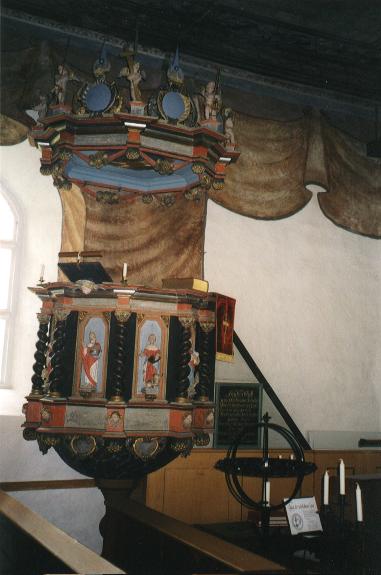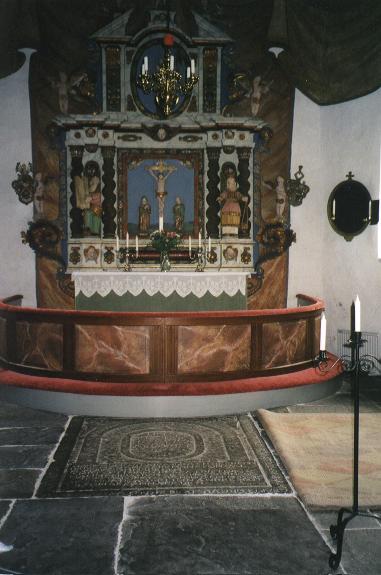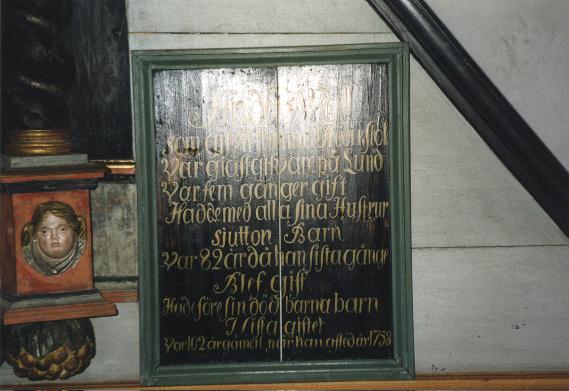
The pulpit donated
by Anders Månsson Wall.
Photo, the summer of 2000
Click to enlarge!
|

The altarpiece and
grave of Anders Månsson Wall.
Photo, the summer of 2000
Click to enlarge!
|
The altarpiece was a gift from Erik Månsson Ulfsparre. His and Soops coat of arms are placed on each side of the altarpiece.
The pulit is donated by the churchwarden and Innkeeper från Lunds Inn. About his interresting familyhistory tells a painting hanging on the pulpit.
This painting was noted in the inventory from 1774. The donator of the pulpit Anders Wall 1) is buried
just in front of the altar under a big carved grave-slab.

The painting that tells about Anders Månsson Wall. 2)
Photo, the summer of 2000
Click to enlarge!
|
The baptismal font made of sandstone dates from the beginning of the 13th century or even earlier. In the gallery there is an old aokchest from the 11th century. The form of the chest dates if from the hedonism area. If was found during archaeological research in 1929.
The churchsilver is palced in a chest by the altar. The chest has three locks and you have to have all three keys to open the chest. Earlier the priest had one of the keys and the two ohters had the churchwardens.
The goblet and the pâté was donated by Anna Maria Dreffensköld in 1738.
In an exhibition case is a chasuble from the the Middle Age knitted with silver thread. It it most likely a war-trophy from the 30-years-war. The main theme is the death of
the Virgin Mary.
On the north wall a painting is hanging called "Christmas eve by the grave". It was made by the artist Otto Hesselbom and is a gift from his nephew Gösta Hesselbom. The artist was born in Ånimskog and is buried in the churchyard under a 300 cm high stone with his portrait.
The wooden shield with a the moon on the wane is the family Måneskölds funeral cote of arms, dated from 1652.
The church got electric heating in 1956.
In 1929 and in 1960 the interior of the church was renovated and got is present look.
In the churchyard there is a monemet over the first female churchwarden, Gerda de Verdier. She has donted land to the church to be the new churchyard, the beautiful carpet by the sanctuary and her own bridal crown in gilded silver. The youngest part of the churchyard and the monument are design by the architect Edvard Jacobsson, Karlstad.
The mortuary, that was built in 1957, and the parish house was outlined by the architect firm Havstad Hollström Lindell, Karlstad.
The lime trees on the older part of the churchyard was planted in 1820.
 The grave-slab in Ånimskogs church.
The grave-slab in Ånimskogs church.
1) Anders Wall who was the donator of the pulpit was Håkans great great great great great great great grandfather. Read more about Anders Wall.
2) The information that he died in 1758 is wrong. Anders Månsson Wall died on November 30 1738.
Copyright © Håkan Bergström, Latest update 2003-12-31



